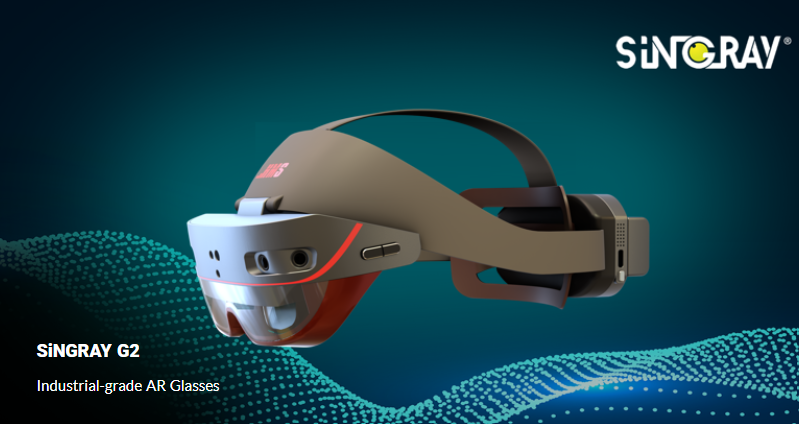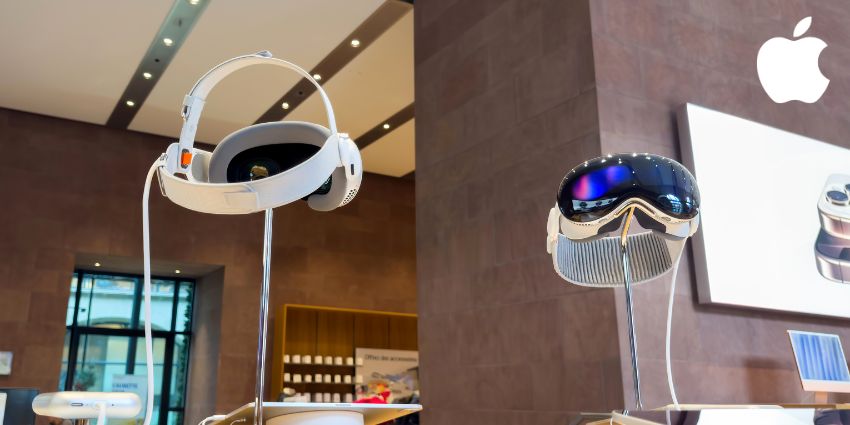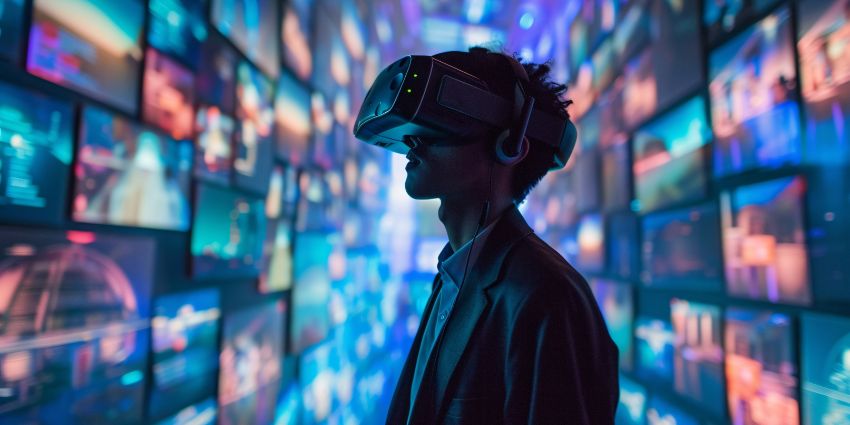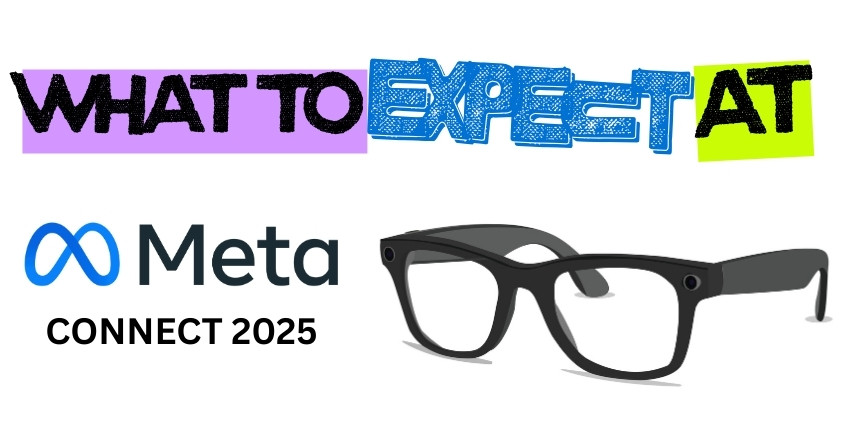If you thought Google’s moment in the XR spotlight had passed, this Android XR guide might just change your mind. Google might not be ready to launch a new pair of Google Glasses anytime soon, but the launch of Android XR could still reshape the future of immersive technology.
Google’s play on a brand-new, truly “open” XR platform was built from the ground up with AI, spatial computing, and modularity in mind. Compared to some previous XR development solutions, plagued by vendor lock-in, closed ecosystems, and overpriced hardware, Android XR has a lot to offer. It could potentially shape the future of enterprise XR.
So, what exactly is Android XR, what are the core features, the use cases, and the benefits, and what lies ahead for Google’s evolving ecosystem?
Android XR Guide: What is Android XR?
Android XR is Google’s next-generation operating system built specifically for extended reality. Introduced by Google in December 2024, and evolving from the foundations of the “Android” operating system, this new solution forms the foundation of a new unified ecosystem.
It’s not just the software behind Google headsets or smart glasses – or even the new XR devices Google is partnering with companies like Samsung to build. It’s an investment in democratizing the XR space. Instead of creating a walled garden, like Meta initially did with Horizon or Apple does with VisionOS, Google is opening the gates.
It’s positioning itself as the fuel behind future XR products, offering organizations access to open-source solutions that work across vendors, development tools, and use cases.
Within the ecosystem, innovators can access pre-built Google systems, like Gemini, the AI assistant, software development kits, and flexible, familiar tools like Android Studio and Unity. Developers can build once and deploy across multiple form factors without rewriting entire codebases.
This isn’t Google’s first Rodeo in XR, but Android XR seems like a more collaborative initiative than previous projects like Google Glass. Already, Google has joined forces with Samsung, Qualcomm, Unity, and Magic Leap, and that’s just the beginning.
Android XR: Where it Sits in the Android Ecosystem
As you’ll see throughout this Android XR guide, this new project isn’t a side hustle for Google – it’s a fully integrated part of the Android family. That means if your enterprise is already running Android smartphones, tablets, or MDM tools, you’re halfway to XR.
AndroidXR taps directly into the existing Android framework. Your developers can use Android Studio. The IT team can manage devices via familiar tools. Your apps can deploy through the Play Store. That’s huge for enterprises already invested in Android’s ecosystem.
Google is also going all-in on AI and XR convergence – infusing the platform directly with the Google Gemini family. Companies can access Gemini models to create apps and experiences enhanced with spatial awareness and multimodal content recognition.
Already, Google has shown off some of the benefits, exploring how users can access Gemini to interact with applications using voice, gesture, and eye tracking, so there’s no need for menus. Need to translate a sign in real time? Gemini can do that too. Want real-time step-by-step instructions while repairing a turbine? Just look and ask.
This AI integration makes Android XR a force multiplier for enterprise apps. Think contextual assistance during training, real-time data overlays during field operations, and hands-free workflows in sterile environments like hospitals or cleanrooms.
Because AndroidXR works well with Unity and Unreal Engine, it fits seamlessly into your existing pipeline, whether you’re designing immersive product demos or complex digital twins.
Android XR Guide: The Key Features
Android XR as an ecosystem is still in its early stages, but it already stands out for features like flexible modularity. If Google is successful with this venture, it will open the door to a new era of versatile innovation, unlike anything we’ve seen before.
Modular By Design
Android XR is modular from the ground up. That means manufacturers and developers can plug in what they need – and leave out what they don’t. You can add your favorite Gemini model, implement eye tracking and hand tracking features, empower users to jump between virtual reality and mixed reality instantly – you name it.
The Android XR stack also includes “OpenXR” – a cross-platform API focused on portability and versatility. Google announced that this solution will come with a range of world-sensing capabilities, such as AI-powered hand mesh, sophisticated light estimation capabilities, detailed depth textures, and new “trackability” for devices like laptops.
Android XR isn’t tied to one form factor or way of doing things. It supports everything from spatial panels and audio overlays to Bluetooth peripherals and multimodal input.
For enterprises, this means ultimate flexibility. Using the same core OS, you can build headsets for training, glasses for frontline teams, or immersive rooms for product design.
And since it’s designed to scale across smart glasses, VR headsets, AR phones, and future wearables, you’re not stuck on a single device path. Your tech investment can evolve without throwing out your entire software stack.
Flexible Open-Source Tooling
Speaking of developer flexibility, Android XR is designed to make it as easy as possible for creators to take advantage of the landscape. The system supports many of the tools devs are already familiar with, like the Android Studio and ARCore, as well as OpenXR.
Plus, Google is rolling out full Android XR SDK support inside Android Studio. You’ll also find integration with Unity, Unreal Engine, and WebXR, allowing developers to use the tools they already love.
Google also adds the “Play Store” to Android XR, where users can access their favorite apps. For instance, you can experiment with Google Chrome, Photos, Maps, and Meet in extended reality. There will also be dedicated versions of apps, like YouTube and Google TV, for immersive entertainment. As Google develops more apps and features, they’ll also be available in Android XR.
Plus, they’ll be able to collect insights from applications, using tools like Google’s “Play Console Insights” application- perfect for tracking user experiences.
Broad Hardware Compatibility
Unlike Apple, Meta, and many other XR developers, Google hasn’t just designed Android XR to support it’s own headsets and future smart glasses. Android XR can run on a wide range of systems, from smartphones with AR capabilities, to smart glasses, and headsets.
Already, Google and Samsung are working on the new Project Moohan headset. Thanks to Google Gemini, this new headset will feature state-of-the-art displays, XR passthrough capabilities, and natural multimodal input. We still don’t have much insight into the exact features this headset will include. According to early testers, however, the headset feels and looks like a Meta Quest Pro, with the visual quality of the Apple Vision Pro. Going forward, it plans on working with and supporting a wide range of spatial computing device vendors.
This agnostic approach to hardware means that organizations will be able to select devices in the future based on the ergonomics, battery life, and features they need, rather than being constrained by a single company’s roadmap. They’ll also be able to experiment with more phased rollouts and mixed-device environments, without having to navigate different ecosystems.
AI at the Core
As mentioned a little earlier in this Android XR guide, a key feature of the operating system is that it includes direct access to Gemini – Google’s family of AI tools. Gemini empowers companies with access to a range of multimodal models that can support all kinds of intelligent experiences.
Companies can build applications and experiences that allow headsets and glasses to see what the user is looking at and provide real-time insights, or translate conversations instantly. They can design spatial computing systems that allow for natural, gesture or voice-based interactions with apps, so employees and teams can complete tasks hands-free.
In enterprise use, that translates to things like AI-assisted repairs, guided training, or on-the-fly customer support. Unlike cloud-only assistants, Gemini can work offline, critical for fieldwork, security-sensitive industries, or low-connectivity zones.
Security, Compliance, and Enterprise Readiness
Android XR was designed with Enterprise IT in mind. Built-in support for mobile device management (MDM) tools, like Microsoft Intune and ArborXR, lets you manage fleets of devices, push updates, and enforce policies, just like phones and tablets.
Companies can access features like device attestation, Google Play Protect, and conditional access. There’s support for securing data in transit and at rest with apps too, through developer systems. Google has yet to roll out something exactly the same for “Meta Quest for Business” – but there’s every chance that future developers could offer a similar experience.
Another major thing that makes Android XR more appealing to enterprises is it’s scalability. That open ecosystem and modular architecture allows companies to experiment with XR investments, without experiencing the same bottlenecks created by other vendors.
Ideal Use Cases for Android XR in the Enterprise
Since it’s still in its infancy, and major headsets like Samsung’s XR device haven’t been released yet, we don’t have a lot of case studies highlighting exactly what the system is capable of. The big difference between Android XR and other ecosystems is that it’s going to have the ability to power so many different experiences, across devices. Some major use cases include:
Remote Collaboration & Field Assistance
Let’s start with a challenge every enterprise faces: distributed teams.
Whether it’s a technician in the field, a sales rep on-site, or a surgeon consulting across the globe – XR changes everything, and Android XR will make accessing it frictionless. Already, Google has announced that developers will be able to access passthrough video through the operating system – which will be ideal for remote collaboration and field work.
This is also a feature that Meta has yet to offer it’s developer community – which could give Google a chance to get ahead. Addi in Gemini AI, and users will even be able to access AI-powered assistants on the move, for real-time translation or machine diagnostics.
Immersive Training & Simulation
Immersive training opportunities are already a big use case for all kinds of XR platforms in the enterprise. Android XR will allow companies to create more custom training environments that work perfectly with a range of devices.
You could create an XR app that allows one technician to dive into a complex simulation in VR, and another to provide feedback with a set of smart glasses. With Unity or Unreal Engine support, companies can develop ultra-realistic, gamified simulations. Want to track learner progress? Overlay AI analytics via Gemini and get adaptive training in real time.
Business leaders will even be able to review performance metrics and data on computers and smartphones wherever they are – or personalize training scenarios in real-time.
Digital Twins & Data Visualization
Digital Twins aren’t just great for training. They’re fantastic for gathering data and insights too. With Android XR, companies will be able to create real-time interactive replicas of assets, systems, and processes that they can track from just about any device.
This means in smart factories; managers can walk through a live model of a production line in VR. They can check sensor data, run simulations, and even “test” repairs before doing them in real life. In utilities, Android XR-enabled smart glasses can overlay pipeline data or stress loads directly onto the physical infrastructure.
Gemini AI could enhance this experience with predictive insights. Want to see when a component might fail? Or visualize the impact of adjusting a system parameter? All you need to do is add in the right AI model, and you’re ready to go.
Product Development & Design
For businesses that build physical products, like automotive companies, medical device organizations, or those in consumer electronics, Android XR could be incredible. Design teams will be able to use XR to collaborate in shared spatial environments, accessing the connected tools and apps already available on the Google Play store.
Engineers can inspect 3D models from all angles. Teams can annotate, iterate, and test concepts without waiting for physical prototypes. Employees might even be able to meet through connected apps like Google Meet. This means faster iteration cycles, fewer design errors, and quicker time to market.
Design teams using Android XR can also involve end users in the process. Need to gather direct feedback on a new store layout or packaging concept? You could let them walk through the experience in XR first.
Customer Experience & Engagement
Speaking of interactions with customers, extended reality can go beyond internal processes. With Android XR, companies can build unforgettable immersive experiences and publish them on the Google Play store. They can even make those experiences accessible to people who don’t have expensive headsets or smart glasses. Thanks to Web XR, apps can even launch in a browser.
Retailers can create virtual try-on experiences or interactive showrooms. Real estate agents can walk clients through virtual properties. Automotive brands can let customers explore a new model, down to the stitching on the seats, without any travel.
Because Android XR supports Android apps, you can scale these experiences to tablets, kiosks, and in-store displays, too. That takes unified branding and cross-platform reach to the next level.
Android XR vs. Apple Vision Pro & Meta for Business
Obviously, Google isn’t the first company to build its own XR ecosystem. Apple launched the Apple Vision Pro, the proprietary VisionOS platform. Like Google’s Android XR, this offers companies access to apps and tools already available in Apple’s ecosystem. However, it’s not an “open platform” that plays nicely with every headset and device. Apple’s environment is still a walled garden.
Apple also had very little experience with AI when it released the Vision Pro. Although it described the device as a spatial computer, AI-specific features were limited initially. Even now, Apple is behind the curve somewhat in terms of AI functionality.
Meta is often seen as the company to beat from an XR ecosystem perspective. The Horizon operating system is huge, and now it’s more accessible. Meta reintroduced the platform as an open service for third-party headsets outside of the Quest ecosystem in 2024.
Like Google, Meta also has a strong presence in the AI space, with its own proprietary language models and multimodal systems. Meta is also a little ahead of Google on offering specific solutions for enterprises, with the Meta Quest for Business system, which includes access to MDM and access management controls.
Still, Meta still isn’t as flexible as open as Google. Meta Quest headsets still depend on Qualcomm processors, and although Meta is exploring partnership opportunities, there’s a way to go. Plus, as mentioned above, Meta doesn’t offer all the development resources Android XR provides – like camera passthrough for headsets.
Android XR Guide: Deployment Tips
If you’re sold on Google’s AI-first, flexible, and open XR ecosystem, the next step is figuring out a deployment strategy. Obviously, the approach to this depends on whether you’re going to be using Android XR as a development platform or accessing it through a third-party device.
Fortunately, the same best practices you’d use for any XR strategy still apply:
- Start Small: Pilot programs always make sense, whether you’re testing a new development framework, headset, or pair of AR glasses. Identify a use case for your team, and start with a group of early adopters that can test systems, and gather feedback.
- Align IT and Security Teams: XR introduces new endpoints and risks to any enterprise network. That means you need a strategy in place for protecting data, controlling access to apps, and monitoring compliance, throughout your use cases.
- Manage Content Carefully: Take advantage of intuitive enterprise-software for app and content management. Make sure you can monitor, update, and patch applications remotely, and track metrics and usage information from anywhere.
- Integrate Everything: The great thing about Android XR is that it’s inherently flexible, designed to connect with the systems you already use. Take advantage of that fact. Don’t let gaps and missing connections hold you back.
- Stay Experimental: Pay attention to new Android XR updates, SDKs, development tools, and even headsets built with the operating system as they emerge. Monitor the impact of your tech, and get ready to scale over time.
Need more advice? Find out how to integrate Android XR into your digital transformation strategy here.
Android XR Guide: What’s Next?
Since it first announced the arrival of Android XR, Google hasn’t stood still. It’s not just calling it a day with the Project Moohan headset from Samsung. Nor is it just working on a new smart glasses operating system. Google is constantly moving forward with new partners. It’s already exploring opportunities with various well-known vendors like Sony and Magic Leap.
The open nature of Android XR will also mean that more new and up-and-coming startups can take advantage of Google’s tools too – which could mean we have endless new headsets to explore in just the next few years.
Google will continue to integrate Android XR into the broader Google roadmap too. This could mean we see Google Meet in immersive mode, Android smartphones used as XR controllers and secondary displays, and new dedicated environments in the Play store.
The company is investing heavily in Gemini, and exploring new ways to infuse artificial intelligence into extended reality strategies. Future Gemini updates could lead to the introduction of models that support predictive analytics, real-time sentiment recognition, and more.
Why Android XR Is the Future of Enterprise XR
Hopefully, this Android XR guide has offered a useful insight into just how transformational Google’s new ecosystem could be. Rather than trying to compete directly with other hardware vendors based on flashy headset launches alone, Google is building a new foundation for immersive technology.
It’s paving the way for a future built on open standards, real developer freedom, scalable enterprise deployment, and AI that actually understands the world around you.
While Apple and Meta continue to build walled gardens, Google is planting seeds for a full-blown ecosystem where the entire XR community can thrive.
If you’re ready to get involved in the next era, learn more about how enterprises can use Android XR here. Or, discover our behind-the-scenes guide to Android XR’s architecture.







